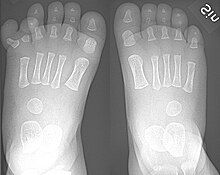X-ray of polydactyly
Jump to navigation
Jump to search
Author:
Mikael Häggström [notes 1]
Choice of modality
X-ray is generally the initial choice.
Evaluation
- Number of supernumerary digits.[1]
- Growth as compared to "normal" digits
- Duplication can be stated at least when it is difficult to structurally distinguish any supernumerary digit from the "normal" digit that shares the same proximal attachment site.
- Structure of the apparent attachment site, for example appearing to form a joint with a certain metacarpal/metatarsal or phalangeal bone:[notes 2][2]
- Whether that proximal bone is normal or for example broadened at the attachment.
- Fusion of even the distal parts of a supernumerary digit (syndactyly) is called polysyndactyly.[3]
- Angulation of the most proximal part of the supernumerary digit, and can usually described as mild/moderate/severe valgus or varus and not necessarily numerically.
- Any other abnormality in the projected skeleton, since the condition is associated with many syndromes.[1]
Reporting
Example:
Right-sided duplication of the right little toe, with two toes (fifth and sixth) apparently forming joints with the fifth metatarsal bone, which is mildly broadened distally. The duplicated toes have almost normal growth. The fifth toe has mild varus angulation, and the sixth toe has substantial valgus angulation. No other abnormalities.
Notes
- ↑ For a full list of contributors, see article history. Creators of images are attributed at the image description pages, seen by clicking on the images. See Radlines:Authorship for details.
- ↑ A description is most important, although a grading system is available for hands:
"Finger polydactyly ". Hand Clin 14 (1): 49–64. 1998. PMID 9526156.
References
- ↑ 1.0 1.1 Dr Daniel J Bell and Dr Yuranga Weerakkody. Polydactyly. Radiopaedia. Retrieved on 2019-01-28.
- ↑ "Central polydactyly- a review of 12 cases and their surgical treatment ". J Hand Surg [Am] 7 (5): 460–5. 1982. doi:.
- ↑ Dr Mark Thurston. Polysyndactyly. Radiopaedia. Retrieved on 2019-01-28.

